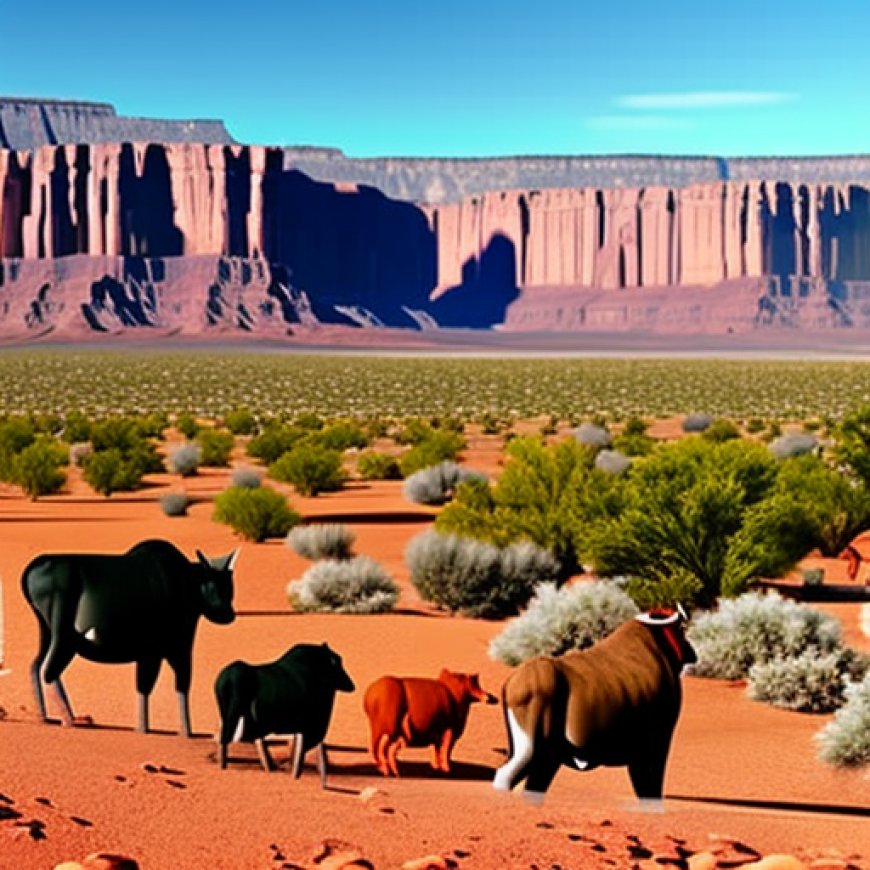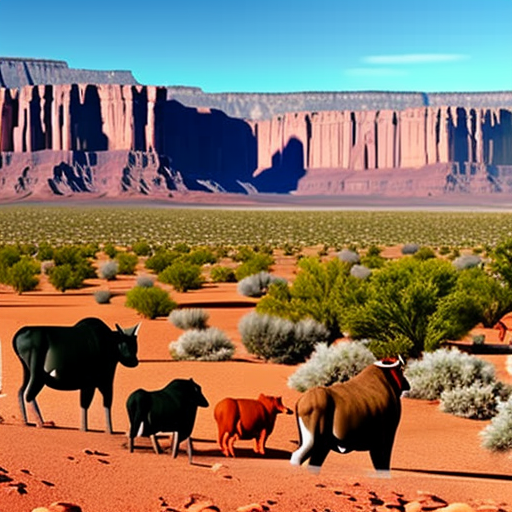Biden Administration Sued Over Destructive Cattle Grazing in Arizona National Monument
Biden Administration Sued Over Destructive Cattle Grazing in Arizona National Monument Center for Biological Diversity


TUCSON, Ariz. Lawsuit Filed to Protect Endangered Species Habitat in Agua Fria National Monument

Introduction
The Center for Biological Diversity and Maricopa Audubon Society have filed a lawsuit against the U.S. Bureau of Land Management and Fish and Wildlife Service for their failure to protect the endangered Gila chub and threatened Western yellow-billed cuckoo from unauthorized cattle grazing in Arizona’s Agua Fria National Monument.
Background
The lawsuit aims to prompt federal agencies to take action and prevent illegal livestock grazing from damaging the habitat of endangered species in the Agua Fria National Monument. The Center for Biological Diversity has expressed concern over the lack of action taken by these agencies over the past four years. The issue of unauthorized grazing extends beyond Agua Fria and is prevalent throughout the Southwest, pushing endangered species to the brink of extinction. The negligence within the Bureau of Land Management and Fish and Wildlife Service field offices needs to be addressed by Washington leadership.
Illegal Livestock Damage
Annual field surveys conducted by the Center for Biological Diversity in Agua Fria National Monument since 2021 have consistently documented illegal livestock damage to designated critical habitat.
Impact of Livestock Grazing
Livestock grazing in the monument and across the desert Southwest has a detrimental impact on threatened and endangered wildlife. It is the primary driver of riparian ecosystem degradation and species imperilment. Removing livestock from riparian areas is crucial to address the extinction crisis in the Southwest.
Lack of Progress
Despite a previous lawsuit in 2022, the Bureau of Land Management has failed to initiate the promised Endangered Species Act consultation. The Center for Biological Diversity’s surveys in 2023 and 2024 revealed ongoing unauthorized grazing and resulting damage to endangered species habitat.
Extent of Damage
Livestock damage in the monument spans five different grazing allotments and includes contaminated streams, trampled streambeds and banks, and vegetation grazed down to the roots in protected critical habitat. The Gila chub may already be extinct in Silver Creek. Additionally, irreplaceable archaeological sites have also been impacted.
Agua Fria National Monument
Agua Fria National Monument was designated in 2000 to protect cultural resources, riparian forests, and biodiversity. The grazing permit for the Horseshoe allotment is held by the Arizona Game and Fish Department, which used federal funds to purchase the Horseshoe Ranch in 2009 with the promise of improving endangered species habitat in the monument.
Widespread Damage
Field surveys conducted in recent years have documented chronic and severe damage caused by unlawful livestock grazing to endangered species habitat along streams, rivers, and tributaries in Arizona and New Mexico. The Center for Biological Diversity has surveyed 70% of designated critical habitat for the threatened yellow-billed cuckoo in these two states and found that cattle grazing has caused moderate to significant damage in 80% of those areas.
Enforcement Challenges
Although litigation and agreements resulting from surveys have required federal agencies to monitor and remove livestock from riparian critical habitat, compliance has been inconsistent. While some areas have seen livestock removed, unauthorized grazing persists in others.
Recognition of the Issue
During a recent court hearing regarding feral cattle on public lands in New Mexico, an attorney representing the federal government acknowledged that “cattle and riparian areas do not mix.”
Importance of Riparian Areas
Riparian areas are crucial for Arizona’s wildlife, with up to 75% of the state’s wildlife species depending on them. However, these areas make up less than 1% of the state’s land. Human activities, including livestock grazing, have destroyed most of Arizona’s low-elevation riparian habitats during the 20th century. The cottonwood-willow riparian forest, still found in Agua Fria National Monument, is now the rarest forest type in North America.
SDGs, Targets, and Indicators
-
SDG 15: Life on Land
- Target 15.5: Take urgent and significant action to reduce degradation of natural habitats, halt the loss of biodiversity, and protect and prevent the extinction of threatened species.
- Indicator 15.5.1: Red List Index
-
SDG 12: Responsible Consumption and Production
- Target 12.4: By 2020, achieve the environmentally sound management of chemicals and all wastes throughout their life cycle, in accordance with agreed international frameworks, and significantly reduce their release to air, water, and soil to minimize their adverse impacts on human health and the environment.
- Indicator 12.4.1: Number of parties to international multilateral environmental agreements on hazardous waste, and other chemicals that meet their commitments and obligations in transmitting information as required by each relevant agreement.
Analysis
The article addresses the issues of illegal livestock grazing and its impact on endangered species habitat in Arizona’s Agua Fria National Monument. The following SDGs, targets, and indicators are relevant to the issues discussed:
1. SDG 15: Life on Land
The article highlights the need to protect endangered species, such as the Gila chub and Western yellow-billed cuckoo, from the negative effects of unauthorized cattle grazing. SDG 15 aims to reduce degradation of natural habitats, halt biodiversity loss, and prevent the extinction of threatened species. Target 15.5 specifically calls for urgent and significant action to achieve these goals. The Red List Index (Indicator 15.5.1) can be used to measure progress in protecting threatened species.
2. SDG 12: Responsible Consumption and Production
The article mentions the environmental damage caused by livestock grazing, including contamination of streams, trampled streambeds, and vegetation degradation. SDG 12 focuses on promoting responsible consumption and production patterns. Target 12.4 aims to achieve environmentally sound management of chemicals and wastes, reducing their release to minimize adverse impacts on the environment. Indicator 12.4.1 measures the number of parties meeting their commitments and obligations in transmitting information on hazardous waste and chemicals.
Table: SDGs, Targets, and Indicators
| SDGs | Targets | Indicators |
|---|---|---|
| SDG 15: Life on Land | Target 15.5: Take urgent and significant action to reduce degradation of natural habitats, halt the loss of biodiversity, and protect and prevent the extinction of threatened species. | Indicator 15.5.1: Red List Index |
| SDG 12: Responsible Consumption and Production | Target 12.4: By 2020, achieve the environmentally sound management of chemicals and all wastes throughout their life cycle, in accordance with agreed international frameworks, and significantly reduce their release to air, water, and soil to minimize their adverse impacts on human health and the environment. | Indicator 12.4.1: Number of parties to international multilateral environmental agreements on hazardous waste, and other chemicals that meet their commitments and obligations in transmitting information as required by each relevant agreement. |
Behold! This splendid article springs forth from the wellspring of knowledge, shaped by a wondrous proprietary AI technology that delved into a vast ocean of data, illuminating the path towards the Sustainable Development Goals. Remember that all rights are reserved by SDG Investors LLC, empowering us to champion progress together.
Source: biologicaldiversity.org

Join us, as fellow seekers of change, on a transformative journey at https://sdgtalks.ai/welcome, where you can become a member and actively contribute to shaping a brighter future.







